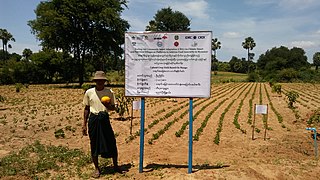The Wuppertal Institute for Climate, Environment and Energy is a German research institution for sustainability research, focusing on impacts and practical application. It explores and develops models, strategies, and instruments to support sustainable development at local, national, and international levels. Research at the Wuppertal Institute focuses on ecology and its relation to economy and society. Special emphasis is put on analyzing and supporting technological and social innovations that decouple the prosperity of economic growth from the use of natural resources. The organization's activities focus on developing transformation processes aimed at shaping a climate-friendly and resource-efficient world.
Governance is the process of making and enforcing decisions within an organization or society. It is the process of interactions through the laws, social norms, power or language as structured in communication of an organized society over a social system. It is done by the government of a state, by a market, or by a network. It is the process of choosing the right course among the actors involved in a collective problem that leads to the creation, reinforcement, or reproduction of acceptable conduct and social order". In lay terms, it could be described as the processes that exist in and between formal institutions.

Environmental planning is the process of facilitating decision making to carry out land development with the consideration given to the natural environment, social, political, economic and governance factors and provides a holistic framework to achieve sustainable outcomes. A major goal of environmental planning is to create sustainable communities, which aim to conserve and protect undeveloped land.
Watershed management is the study of the relevant characteristics of a watershed aimed at the sustainable distribution of its resources and the process of creating and implementing plans, programs and projects to sustain and enhance watershed functions that affect the plant, animal, and human communities within the watershed boundary. Features of a watershed that agencies seek to manage to include water supply, water quality, drainage, stormwater runoff, water rights and the overall planning and utilization of watersheds. Landowners, land use agencies, stormwater management experts, environmental specialists, water use surveyors and communities all play an integral part in watershed management.

Technology dynamics is broad and relatively new scientific field that has been developed in the framework of the postwar science and technology studies field. It studies the process of technological change. Under the field of Technology Dynamics the process of technological change is explained by taking into account influences from "internal factors" as well as from "external factors". Internal factors relate technological change to unsolved technical problems and the established modes of solving technological problems and external factors relate it to various (changing) characteristics of the social environment, in which a particular technology is embedded.
The technological innovation system is a concept developed within the scientific field of innovation studies which serves to explain the nature and rate of technological change. A Technological Innovation System can be defined as ‘a dynamic network of agents interacting in a specific economic/industrial area under a particular institutional infrastructure and involved in the generation, diffusion, and utilization of technology’.
Environmental governance (EG) consist of a system of laws, norms, rules, policies and practices that dictate how the board members of an environment related regulatory body should manage and oversee the affairs of any environment related regulatory body which is responsible for ensuring sustainability (sustainable development) and manage all human activities—political, social and economic. Environmental governance includes government, business and civil society, and emphasizes whole system management. To capture this diverse range of elements, environmental governance often employs alternative systems of governance, for example watershed-based management.
In political ecology and environmental policy, climate governance is the diplomacy, mechanisms and response measures "aimed at steering social systems towards preventing, mitigating or adapting to the risks posed by climate change". A definitive interpretation is complicated by the wide range of political and social science traditions that are engaged in conceiving and analysing climate governance at different levels and across different arenas. In academia, climate governance has become the concern of geographers, anthropologists, economists and business studies scholars.

The United Nations University Institute on Comparative Regional Integration Studies (UNU-CRIS) is a Research and Training Institute of the United Nations University (UNU). Based in Bruges, Belgium since 2001, UNU-CRIS specializes in the comparative study of regional integration and the provision of global and regional public goods, including environmental stability, poverty reduction, peace, and justice.
Type II partnerships were developed at the Johannesburg World Summit on Sustainable Development in 2002. Arising in opposition to the state-centred eco-governmentality of previous approaches to sustainable development policy, the partnerships facilitate the inclusion of private and civil actors into the management of sustainable development. The partnerships are employed alongside traditional intergovernmental mechanisms in order to effectively implement the United Nations' Agenda 21 and Millennium Development Goals, particularly at sub-national level. Although widely acknowledged as one of the most innovative and effective developments in global environmental governance in recent years, the partnerships have faced criticism due to fears of a lack of accountability, and the risk that they may exacerbate inequalities of power between Northern and Southern states. Despite these reservations, there is a general consensus among state and non-governmental actors that Type II partnerships are a significantly progressive step in global environmental governance in general, and sustainable development discourse in particular.
Demand articulation is a concept developed within the scientific field of innovation studies which serves to explain learning processes about needs for new and emerging technologies. Emerging technologies are technologies in their early phase of development, which have not resulted in concrete products yet. Many characteristics of these technologies, such as the technological aspects but also the needs of users concerning the technology, have not been specified yet. Demand articulation can be defined as ‘iterative, inherently creative processes in which stakeholders try to address what they perceive as important characteristics of and attempt to unravel preferences for an emerging innovation’.
Technological transitions (TT) can best be described as a collection of theories regarding how technological innovations occur, the driving forces behind them, and how they are incorporated into society. TT draws on a number of fields, including history of science, technology studies, and evolutionary economics. Alongside the technological advancement, TT considers wider societal changes such as "user practices, regulation, industrial networks, infrastructure, and symbolic meaning or culture". Hughes refers to the 'seamless web' where physical artifacts, organizations, scientific communities, and social practices combine. A technological transition occurs when there is a major shift in these socio-technical configurations.
Transition scenarios are descriptions of future states which combine a future image with an account of the changes that would need to occur to reach that future. These two elements are often created in a two-step process where the future image is created first (envisioning) followed by an exploration of the alternative pathways available to reach the future goal (backcasting). Both these processes can use participatory techniques where participants of varying backgrounds and interests are provided with an open and supportive group environment to discuss different contributing elements and actions.
Multistakeholder governance is a practice of governance that employs bringing multiple stakeholders together to participate in dialogue, decision making, and implementation of responses to jointly perceived problems. The principle behind such a structure is that if enough input is provided by multiple types of actors involved in a question, the eventual consensual decision gains more legitimacy, and can be more effectively implemented than a traditional state-based response. While the evolution of multistakeholder governance is occurring principally at the international level, public-private partnerships (PPPs) are domestic analogues.
Johannes Willem "Johan" Schot is a Dutch historian working in the field of science and technology policy. A historian of technology and an expert in sustainability transitions, Johan Schot is Professor of Global Comparative History at the Centre for Global Challenges, Utrecht University. He is the Academic Director of the Transformative Innovation Policy Consortium (TIPC) and former Director of the Science Policy Research Unit (SPRU) at the University of Sussex. He was elected to the Royal Netherlands Academy of Arts and Sciences (KNAW) in 2009. He is the Principal Investigator of the Deep Transitions Lab.
Eco-restructuring is the implication for an ecologically sustainable economy. The principle of ecological modernization establishes the core literature of the functions that eco-restructuring has within a global regime. Eco-restructuring has an emphasis on the technological progressions within an ecological system. Government officials implement environmental policies to establish the industrial- ecological progressions that enable the motion of economic modernization. When establishing economic growth, policy makers focus on the progression towards a sustainable environment by establishing a framework of ecological engineering. Government funding is necessary when investing in efficient technologies to stimulate technological development.

Green industrial policy (GIP) is strategic government policy that attempts to accelerate the development and growth of green industries to transition towards a low-carbon economy. Green industrial policy is necessary because green industries such as renewable energy and low-carbon public transportation infrastructure face high costs and many risks in terms of the market economy. Therefore, they need support from the public sector in the form of industrial policy until they become commercially viable. Natural scientists warn that immediate action must occur to lower greenhouse gas emissions and mitigate the effects of climate change. Social scientists argue that the mitigation of climate change requires state intervention and governance reform. Thus, governments use GIP to address the economic, political, and environmental issues of climate change. GIP is conducive to sustainable economic, institutional, and technological transformation. It goes beyond the free market economic structure to address market failures and commitment problems that hinder sustainable investment. Effective GIP builds political support for carbon regulation, which is necessary to transition towards a low-carbon economy. Several governments use different types of GIP that lead to various outcomes. The Green Industry plays a pivotal role in creating a sustainable and environmentally responsible future; By prioritizing resource efficiency, renewable energy, and eco-friendly practices, this industry significantly benefits society and the planet at large.

Climate-smart agriculture (CSA) is an integrated approach to managing land to help adapt agricultural methods, livestock and crops to the effects of climate change and, where possible, counteract it by reducing greenhouse gas emissions from agriculture, while taking into account the growing world population to ensure food security. The emphasis is not simply on carbon farming or sustainable agriculture, but also on increasing agricultural productivity.

Shared Socioeconomic Pathways (SSPs) are climate change scenarios of projected socioeconomic global changes up to 2100 as defined in the IPCC Sixth Assessment Report on climate change in 2021. They are used to derive greenhouse gas emissions scenarios with different climate policies. The SSPs provide narratives describing alternative socio-economic developments. These storylines are a qualitative description of logic relating elements of the narratives to each other. In terms of quantitative elements, they provide data accompanying the scenarios on national population, urbanization and GDP. The SSPs can be quantified with various Integrated Assessment Models (IAMs) to explore possible future pathways both with regards to socioeconomic and climate pathways.

Jennie C. Stephens is an academic researcher, professor, author, and social justice advocate. She is Professor of Sustainability Science & Policy at Northeastern University in Boston, Massachusetts. She is also affiliated with the Women's, Gender and Sexuality Studies Program, the department of Civil & Environmental Engineering and the department of Cultures, Societies & Global Studies.






